-1.png)
11 Best V0 Alternatives 2025: Real Reviews & Pricing
Sep 9, 2025
V0 by Vercel is solid for generating React components, but what if you need more than just frontend UI?
Look, V0 does one thing really well - it takes your text prompts and spits out clean React components with Tailwind CSS. Perfect if you're building in the Vercel ecosystem and just need UI pieces.
But here's what V0 can't do(as of now):
- Build full applications with backend logic
- Work outside the React/Next.js world
- Handle databases, authentication, or server-side code
- Generate mobile apps or desktop applications
That's where these 11 alternatives come in. Some do everything V0 does but better. Others go way beyond UI generation to build complete applications.
What you'll find in this guide:
- Real user experiences and honest reviews
- Tools that actually build full apps (not just UI)
- Alternatives for different tech stacks and use cases
- Pricing breakdowns and when each tool makes sense
Whether you're stuck in V0's limitations or just want something more powerful, let's find your perfect alternative.
11 Best V0 Alternatives in 2025 (Real User Reviews)
V0 by Vercel is solid for generating React components, but what if you need more than just frontend UI?
Look, V0 does one thing really well - it takes your text prompts and spits out clean React components with Tailwind CSS. Perfect if you're building in the Vercel ecosystem and just need UI pieces.
But here's what V0 can't do:
- Build full applications with backend logic
- Work outside the React/Next.js world
- Handle databases, authentication, or server-side code
- Generate mobile apps or desktop applications
That's where these 11 alternatives come in. Some do everything V0 does but better. Others go way beyond UI generation to build complete applications.
What you'll find in this guide:
- Real user experiences and honest reviews
- Tools that actually build full apps (not just UI)
- Alternatives for different tech stacks and use cases
- Pricing breakdowns and when each tool makes sense
Whether you're stuck in V0's limitations or just want something more powerful, let's find your perfect alternative.
0. Comarketer.dev
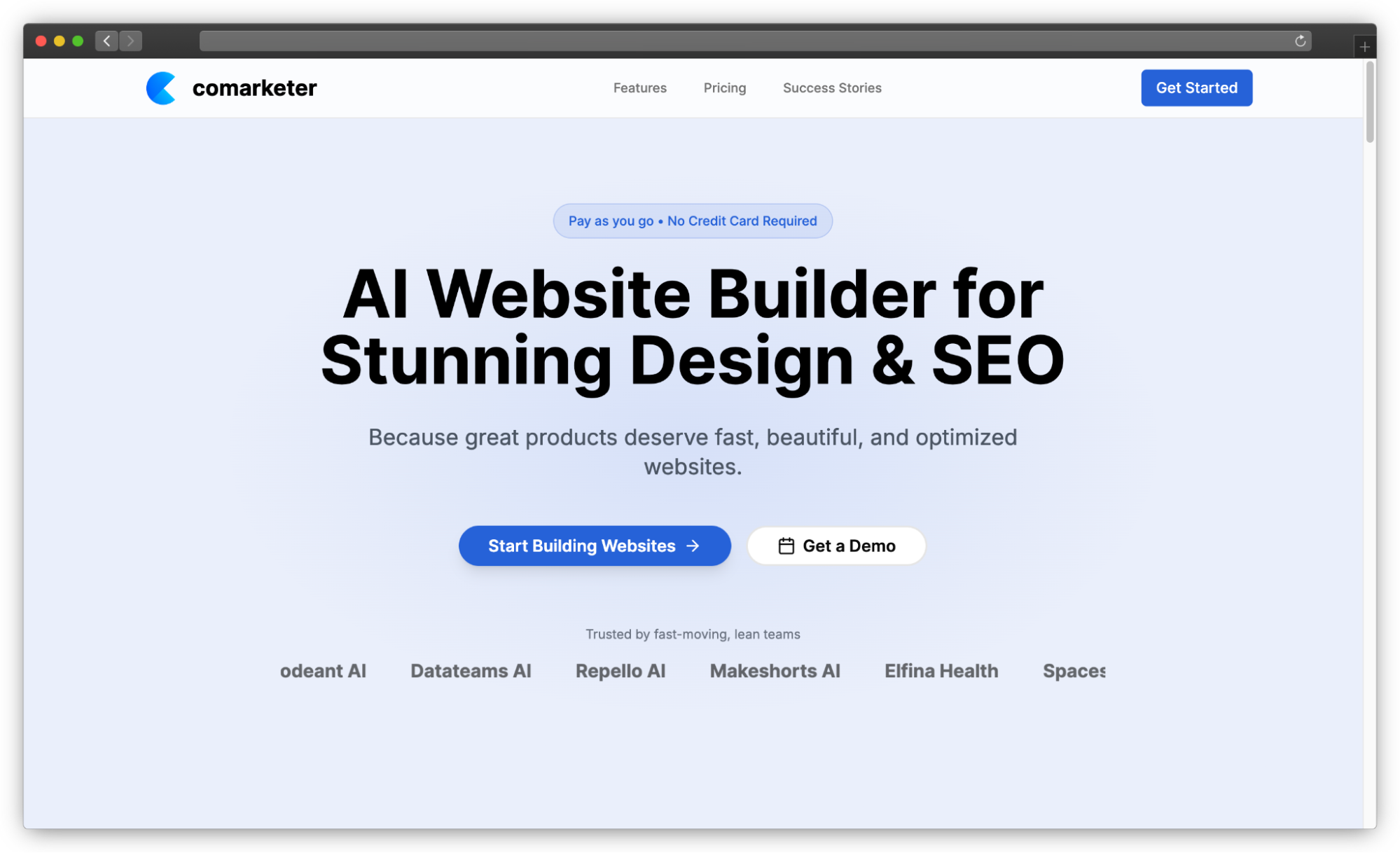
What it is: AI-powered website builder with chat-based interface that generates professional, SEO-optimized websites. Combines prompt-based creation with visual editing and code access for maximum flexibility.
Pros:
- Generates complete websites from simple prompts in seconds
- Chat interface feels natural - like talking to a web designer
- Visual editor for non-technical users + full code editor for developers
- Built-in SEO analysis and optimization (auto-generates sitemap.xml, robots.txt)
- One-click Vercel deployment with free custom domain hosting
- Payload CMS integration for dynamic content management
- Mobile-responsive designs out of the box
- Pay-as-you-use model - no subscription traps
Cons:
- Limited to website building (no full-stack apps like V0)
- Not designed for complex web applications or internal tools
- Smaller community compared to established builders
- Credits-based system might not suit heavy users
- Less suitable for developers wanting complete code control from scratch
Pricing:
- Free: 20 credits (builds ~2 complete websites)
- Pay-as-you-go: $15 for 100 credits
- No monthly subscriptions or hidden fees
Reality check: Transparent pricing with no token surprises. Two professional websites for free, then predictable costs.
Best for:
- Founders and agencies needing professional business websites fast
- Marketing-focused sites that need to rank in search
- Teams wanting AI speed without sacrificing customization
- Users who prefer chat-based editing over drag-and-drop
- Projects requiring both visual editing and code access
1. Bolt.new
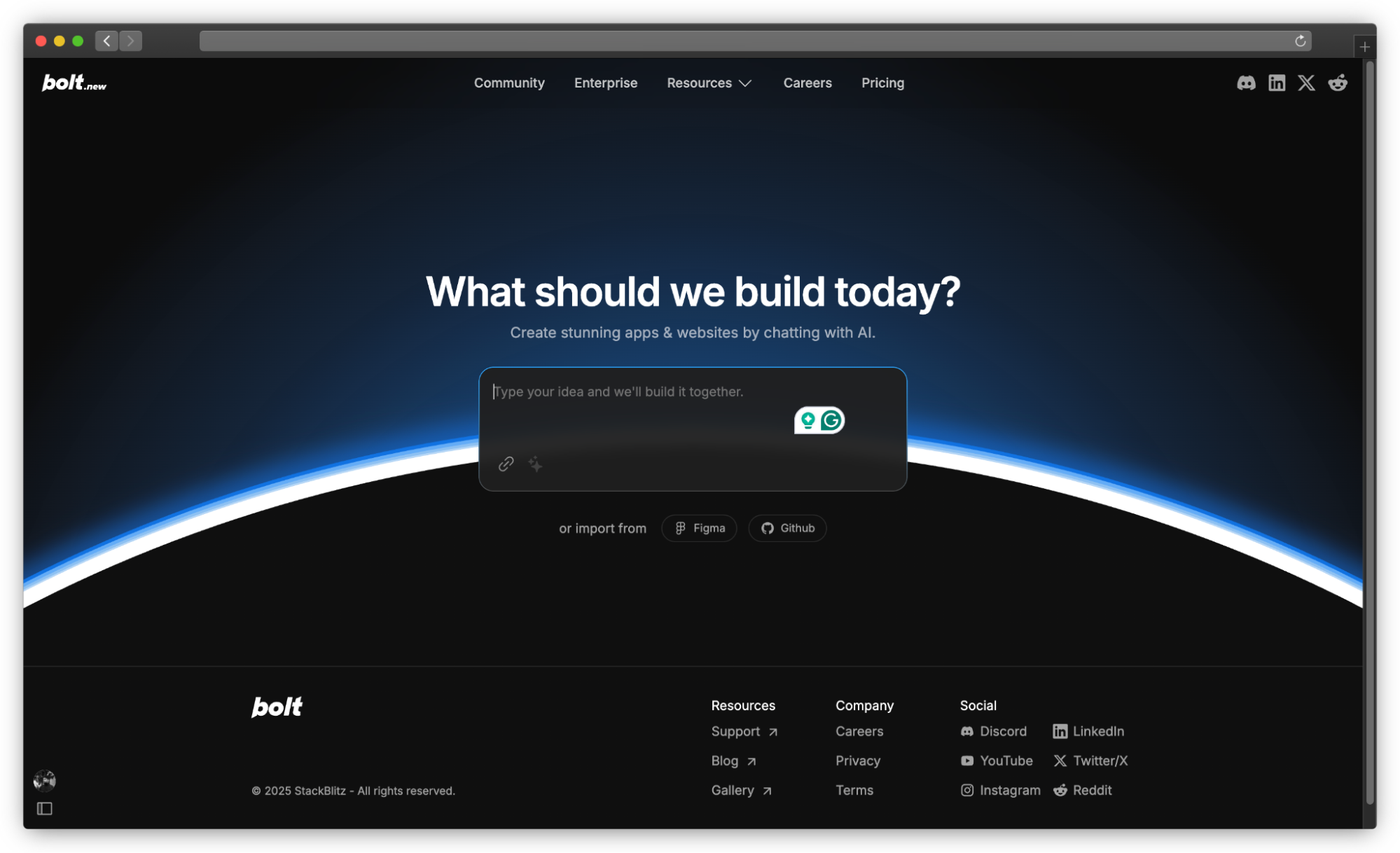
What it is: Browser-based AI that builds full-stack React apps with backends using Claude 3.5 Sonnet. No local setup needed - everything runs in WebContainers.
Pros:
- Builds complete apps (frontend + backend + database) from simple prompts
- Supports React, Next.js, Vue, and Svelte with npm packages
- One-click deployment to Netlify
- Great for rapid prototyping and demos
- Works entirely in the browser
Cons:
- Token consumption is insane - users burned 20M tokens fixing single auth issues
- Rewrites entire files instead of targeted fixes, breaking working code
- Projects break after 1,000 lines of code - AI starts hallucinating
- Code mysteriously disappears during builds
- Poor debugging - can't make incremental fixes
Pricing:
- Free: 1M tokens/month (burns through fast)
- Pro: $25/month (10M tokens)
- Teams: $30/month (10M tokens/member)
- Enterprise: Custom.
Reality check: Complex projects eat 200k+ tokens per prompt, hitting $1,000+ monthly costs
Best for:
- Quick landing pages and demos
- Learning new frameworks
- Proof-of-concepts under 1,000 lines
- Non-developers building simple apps
2. Lovable
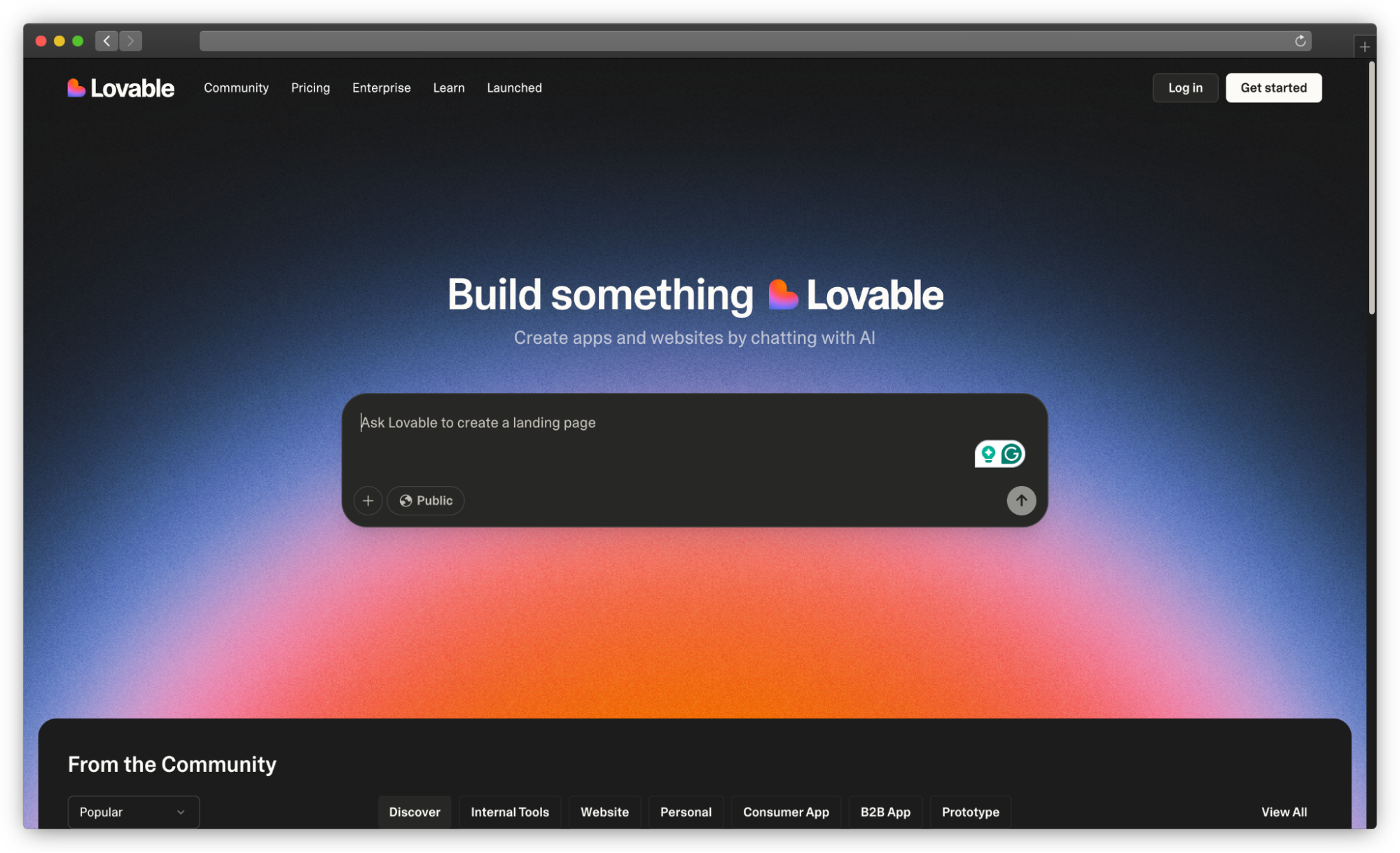
What it is: Chat-based AI that builds full-stack apps with Supabase integration, GitHub sync, and one-click deployment. Claims 20x faster development.
Pros:
- Simple chat interface - describe app ideas in plain English
- Generates frontend + backend + database automatically
- Seamless Supabase integration for real-time features
- Direct GitHub integration with version control
- You own the generated code completely
- Message-based pricing instead of confusing tokens
Cons:
- Can't edit code directly in the platform - stuck with AI suggestions
- Limited to 5 messages daily on the free plan
- Complex apps still require technical knowledge to prompt effectively
- Backend generation sometimes creates overcomplicated architectures
- Real-time collaboration is still in beta
Pricing:
- Free: 5 messages/day, 30/month max
- Pro: $20/month (200 messages + GitHub sync)
- Business: $50/month (unlimited messages + team features)
Best for:
- Non-technical founders building MVPs
- Startup teams needing quick prototypes
- Apps requiring Supabase backend features
- Teams that prefer chat over code editing
3. UI Bakery
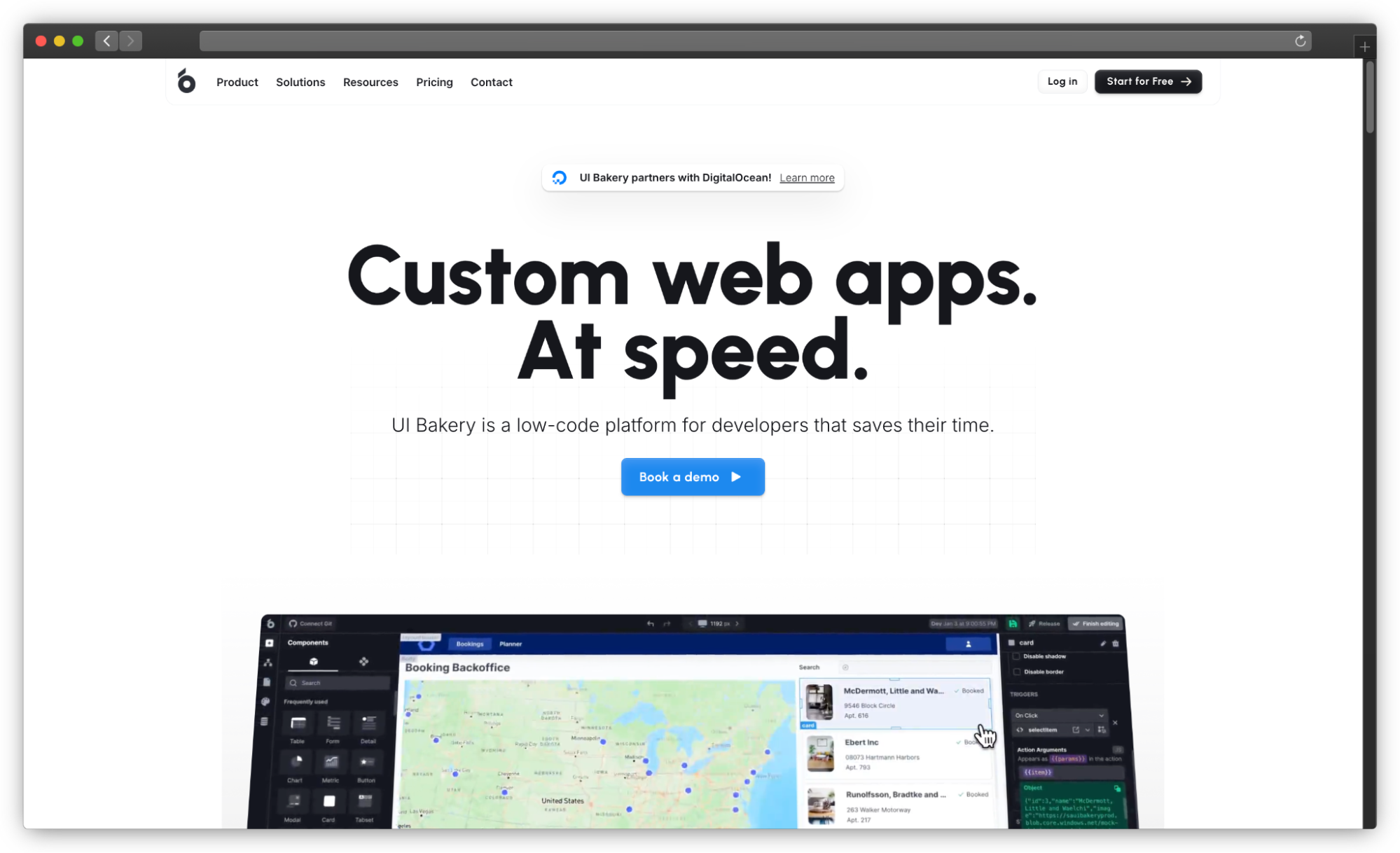
What it is: Low-code platform focused on internal business tools with AI assistance. Built for connecting databases and creating admin panels, dashboards, and CRUD apps.
Pros:
- Excellent database connectivity (PostgreSQL, MySQL, MongoDB, Google Sheets, Airtable)
- 75+ pre-built components for business apps
- Strong security and compliance features
- Visual drag-and-drop interface with custom JavaScript support
- Great customer support - users consistently praise responsiveness
- Self-hosted options available
Cons:
- Requires some technical knowledge - not truly no-code
- Learning curve for complex app building
- AI features are limited compared to full AI builders
- Pricing gets expensive for larger teams
- More suited for internal tools than consumer apps
Pricing:
- Free: Unlimited apps, basic features
- Standard: ~$10/month (10 apps, unlimited data sources)
- Business: ~$25/month (unlimited apps + collaboration)
- Enterprise: Custom pricing
Best for:
- Internal business tools and admin panels
- Companies with existing databases
- Teams building CRUD applications
- Organizations requiring compliance and security
4. Cursor
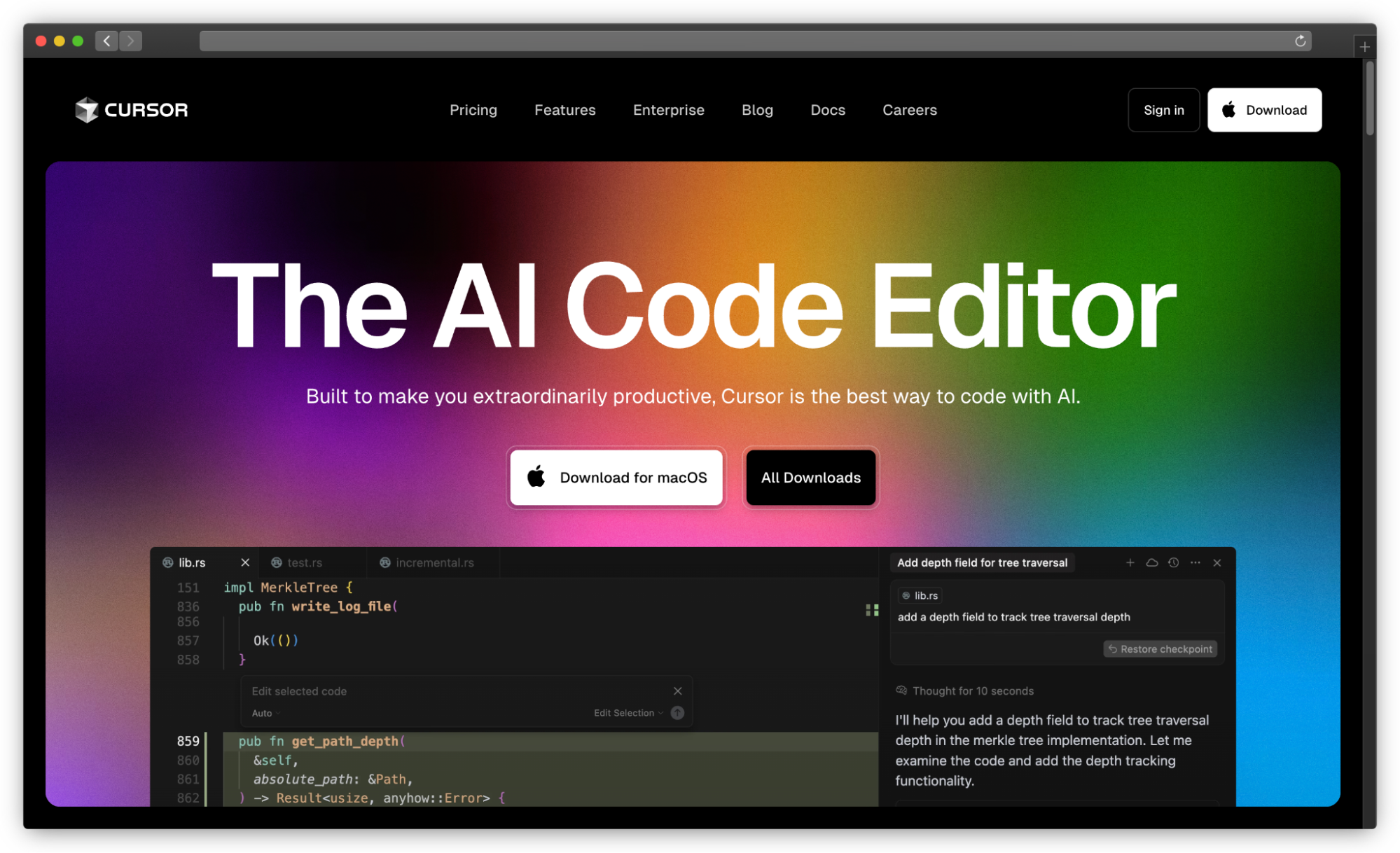
What it is: AI-powered VS Code fork with Claude 3.5 Sonnet, GPT-4, and other models built directly into the editor. Acts as an AI coding partner.
Pros:
- Familiar VS Code interface with powerful AI integration
- Multi-file code generation with Composer mode
- Smart context awareness through codebase indexing
- .cursor rules for project-specific AI behavior
- Tab completion that's faster and smarter than Copilot
- Works with existing VS Code extensions
Cons: The interface can get cluttered with AI buttons and popups
- AI suggestions range from brilliant to completely wrong
- Recent updates caused crashes and performance issues
- Customer support is reportedly slow or non-existent
- Usage limits on "fast" vs ."slow" requests create confusion
Pricing:
- Free: 200 completions, 50 fast requests with GPT-4
- Pro: $20/month (unlimited completions, 500 fast requests)
- Business: $40/month (centralized billing, admin controls)
- Ultra: $200/month
Best for:
- Developers already using VS Code
- Complex refactoring across multiple files
- Teams wanting AI assistance without changing workflows
- Projects requiring precise context control
5. Replit
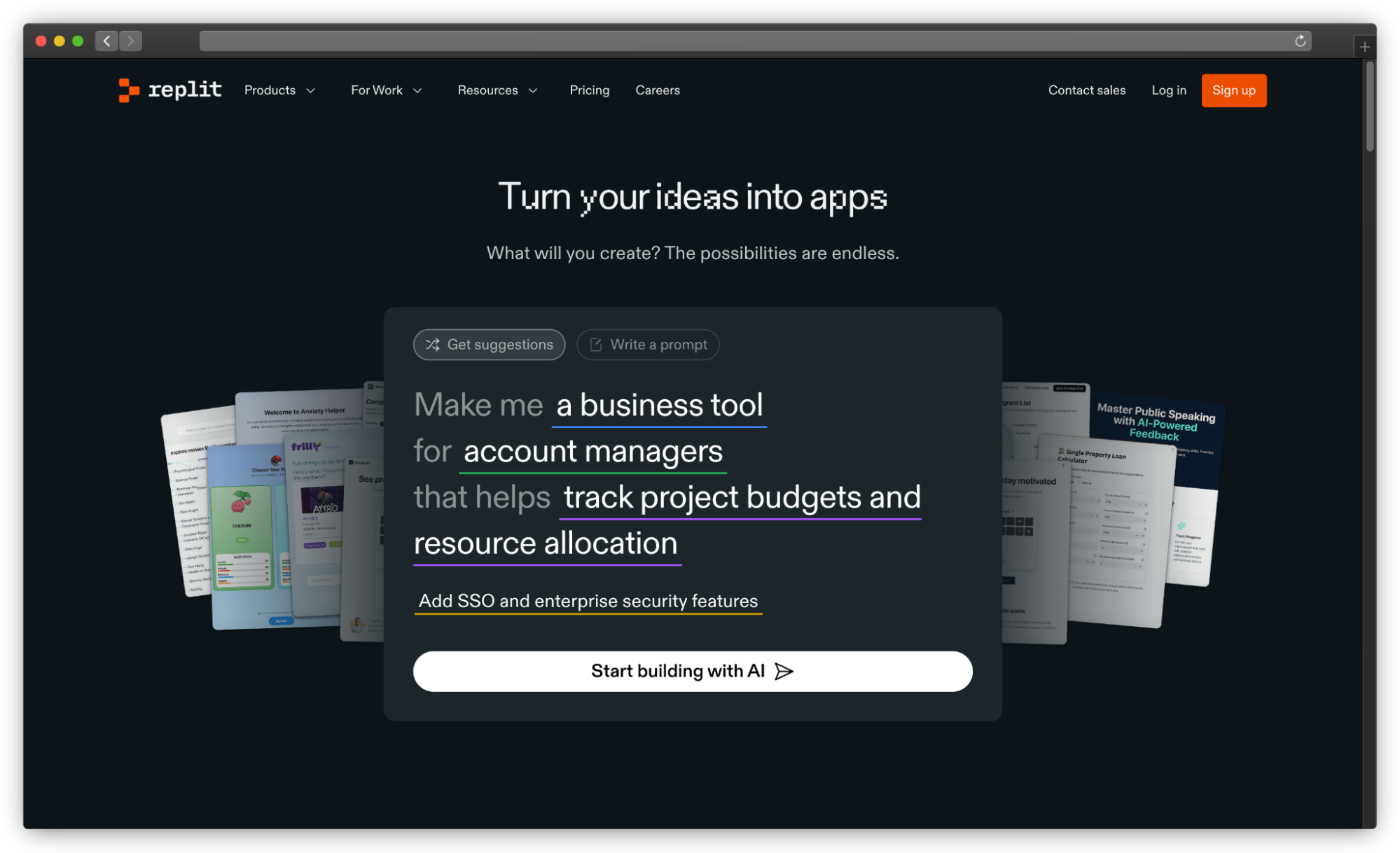
What it is: Cloud IDE with Replit Agent - an AI that builds complete apps from prompts. Everything runs in the browser with instant deployment.
Pros:
- Zero setup - code from any device with internet
- Agent builds complete apps from single prompts
- Supports 50+ programming languages
- Built-in collaboration and version control
- Instant deployment and sharing
- Great for learning and education
Cons:
- Agent pricing is confusing - charged per "checkpoint"
- Performance issues and reliability problems were reported
- Limited local development options
- Support team is unresponsive according to users
- Usage limits feel restrictive on paid plans
- The agent sometimes fails on complex requests
Pricing:
- Free: Basic features, limited AI usage
- Core: $20/month ($25 credits included, unlimited private repos)
- Teams: $35/month per user ($40 credits included, enhanced security, team features)
Pay as you go for more AI credits for agents.
Best for:
- Students and coding beginners
- Quick prototypes and demos
- Collaborative coding projects
- Developers who can't install local tools
6. Windsurf

What it is: AI-native IDE by Codeium with "Cascade" agent that automatically understands context and runs commands. Built on VS Code with a cleaner interface.
Pros:
- Completely free for individual use (no usage limits)
- Cascade agent works like Cursor's Composer, but launched first
- Cleaner, more intuitive UI than Cursor
- Writes code changes to disk before approval
- Strong privacy focus - no training on user data
- Multiple AI models available (Claude, GPT-4, etc.)
Cons:
- Cascade feature can be unreliable - sometimes fails to write files
- Less mature ecosystem compared to Cursor
- Some users report connection issues and bugs
- Limited documentation for advanced features
- The recent acquisition by OpenAI ($3B)is creating uncertainty
Pricing:
- Individual: Completely free forever
- Pro: $15/month per seat
- Teams: $30/user/month
- Enterprise: Custom pricing
Best for:
- Developers wanting free AI coding assistance
- Teams on tight budgets
- Users preferring simpler, cleaner interfaces
- Privacy-conscious developers
7. Magic Patterns

What it is: AI-powered UI design tool for product teams that generates React/Figma components from text prompts, with design system integration and team collaboration.
Pros:
- Generates production-ready React code and Figma exports
- Integrates with existing design systems perfectly
- Real-time multiplayer collaboration on an infinite canvas
- Chrome extension captures UI from any website
- Strong focus on matching existing brand guidelines
- Y Combinator backed with 100k+ components generated
Cons:
- Works best for smaller components, not full applications
- Limited to UI generation - no backend capabilities
- Still a relatively new platform (launched in 2023)
- Pricing not transparent - requires contacting sales
- More focused on design iteration than app building
Pricing:
- Free: Basic features for individuals
- Hobby: $19/month (team collaboration, unlimited exports)
- Pro: $75/month (3.5x limits and more features)
- Enterprise: Custom pricing for large teams
Best for:
- Product teams iterating on UI designs
- Designers working with existing design systems
- Teams needing rapid component prototyping
- Companies wanting branded, consistent UI elements
8. Builder.io
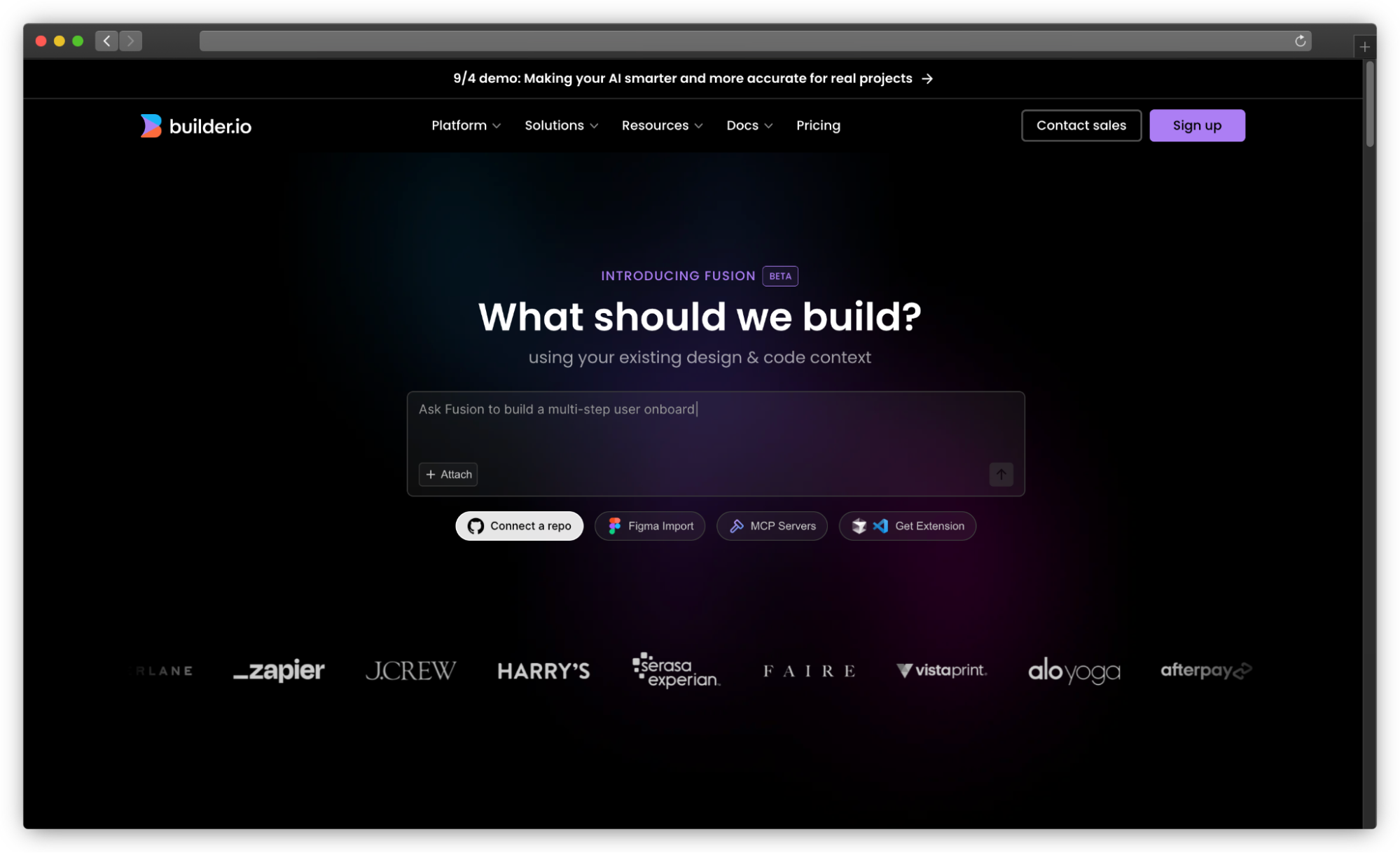
What it is: Visual development platform with AI-powered design-to-code capabilities, drag-and-drop CMS, and enterprise features. Converts Figma designs to production code.
Pros:
- AI converts Figma designs to clean React/Vue/Angular code
- Visual CMS lets non-developers build pages independently
- Integrates with existing codebases and design systems
- Built-in A/B testing and personalization features
- Enterprise-grade with SSO, custom roles, and premium support
- Works with any framework or backend
Cons:
- Steeper learning curve than pure no-code tools
- It can be expensive for smaller teams
- Visual editor crashes reported by some users
- Requires developer setup for advanced integrations
- More complex than simple AI builders
Pricing:
- Free: 1 space, basic features, 10k visual views
- Growth: $24/user/month (500 agent credits, team features)
- Enterprise: Custom pricing (unlimited everything)
Has Pay-as-you-go for more usage
Best for:
- Enterprise teams with existing codebases
- Marketing teams need developer independence
- Companies with complex design systems
- Teams wanting visual editing with code control
9. a0.dev
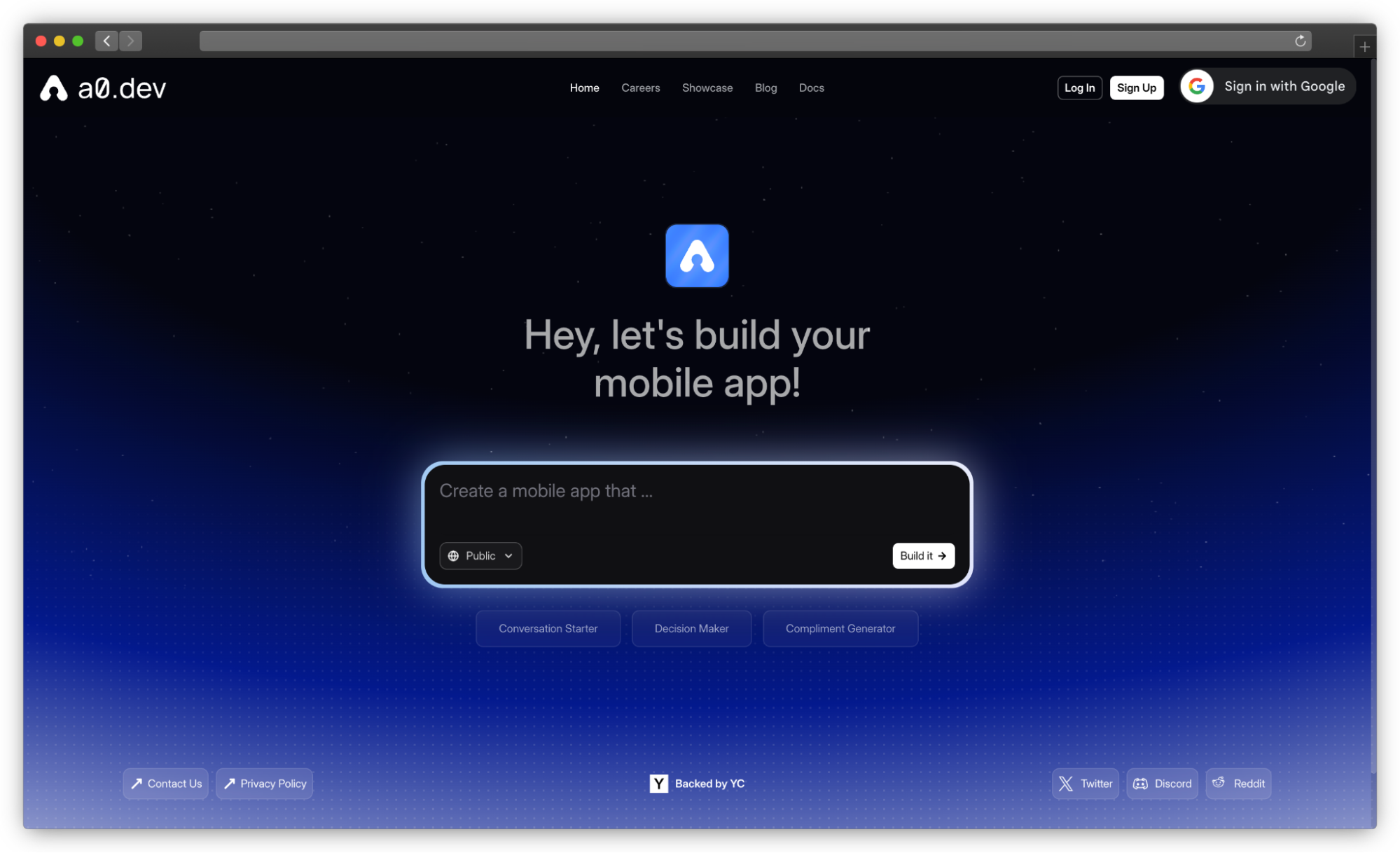
What it is: Y Combinator-backed AI platform that builds complete React Native mobile apps from text descriptions, with instant iOS builds and App Store deployment.
Pros:
- Generates full React Native apps for iOS/Android
- Instant iOS build process (seconds from code to installable app)
- One-click App Store submission with Apple provisioning handled
- Includes backend logic, payments, and monetization features
- AI agent handles debugging and app optimization
- Built by experienced app developers (7 years of mobile experience)
Cons:
- Very new platform (YC W25 batch)
- Limited track record and user reviews
- Mobile-only focus (no web apps)
- Pricing structure not fully clear
- AI-generated apps may need manual refinement
- App Store approval still depends on Apple's policies
Pricing:
- Free: Basic plan for hobby projects (1 app build)
- Starter: $19/month (10-50x higher limits, unlimited builds, payments)
- Production: $99/mo ( Higher priority builds, 2 build concurrencies, and updates for up to 50,000 MAUs)
- Enterprise: Custom pricing for scale
Best for:
- Entrepreneurs wanting to launch mobile apps quickly
- Developers focused on mobile-first products
- Teams needing React Native expertise without a learning curve
- Startups wanting to test mobile app ideas fast
Which V0 Alternative Should You Choose?
For Full-Stack Apps: Bolt.new or Lovable if you need complete applications with backends.
For Enterprise Teams: Builder.io or UI Bakery for existing codebases and team collaboration
For Mobile Apps: a0.dev for React Native or Replit for cross-platform development
For Coding Assistance: Cursor for VS Code users or Windsurf for free AI coding help
For UI Design: Magic Patterns for design systems or ReactAI for simple React components
For Marketing Sites: Comarketer for SEO-focused landing pages
The truth is, no single tool replaces V0 perfectly. Each excels in different areas. Choose based on your specific needs: full-stack development, mobile apps, enterprise requirements, or simple UI generation.
Bottom line: V0 is great for React component generation, but these alternatives offer more specialized solutions for specific use cases. Try a few to see what fits your workflow best.
What next?
Now that you know the 11 best V0 alternatives, here's your action plan:
1. Pick 2-3 tools that match your specific needs from the list above
2. Start with free trials - Most tools offer free tiers or trial periods
3. Test with your actual project - Don't just play around, use it for real work
4. Compare the results - Which one saves you the most time? Which fits your workflow?
5. Consider the costs - Factor in pricing as your usage scales
Remember, the best tool is the one you'll actually use consistently. Don't get caught up in feature lists - focus on what solves your specific problems.
Thanks for reading!
Go grab those free trials and see what works for your exact use case. Each tool has its strengths, so test them with your real projects to find your perfect match.
The AI development space moves fast, so bookmark this guide and check back for updates.
Good luck building! 🚀